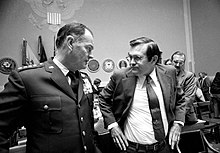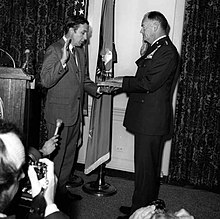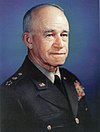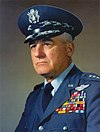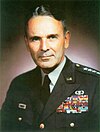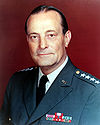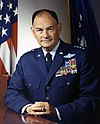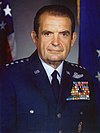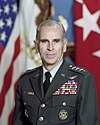
The United States secretary of defense (SecDef) is the head of the United States Department of Defense, the executive department of the U.S. Armed Forces, and is a high-ranking member of the federal cabinet. The secretary of defense's position of command and authority over the military is second only to that of the president of the United States, who is the commander-in-chief. This position corresponds to what is generally known as a defense minister in many other countries. The secretary of defense is appointed by the president with the advice and consent of the Senate, and is by custom a member of the Cabinet and by law a member of the National Security Council.

The Joint Chiefs of Staff (JCS) is the body of the most senior uniformed leaders within the United States Department of Defense, which advises the president of the United States, the secretary of defense, the Homeland Security Council and the National Security Council on military matters. The composition of the Joint Chiefs of Staff is defined by statute and consists of a chairman (CJCS), a vice chairman (VJCS), the chiefs of the Army, Marine Corps, Navy, Air Force, Space Force, and the chief of the National Guard Bureau. Each of the individual service chiefs, outside their JCS obligations, works directly under the secretaries of their respective military departments, e.g. the secretary of the Army, the secretary of the Navy, and the secretary of the Air Force.
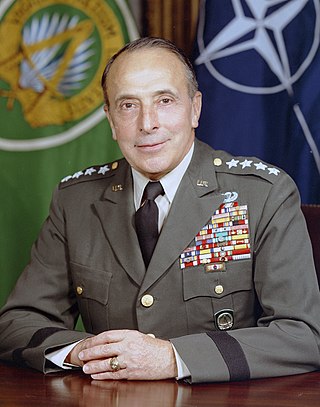
Lyman Louis Lemnitzer was a United States Army general who served as the fourth chairman of the Joint Chiefs of Staff from 1960 to 1962. He then served as the Supreme Allied Commander Europe of NATO from 1963 to 1969.

The vice chairman of the Joint Chiefs of Staff (VJCS) is, by U.S. law, the second highest-ranking military officer in the United States Armed Forces, ranking just below the chairman of the Joint Chiefs of Staff. The vice chairman outranks all respective heads of each service branch, with the exception of the chairman, but does not have operational command authority over their service branches. The vice chairman assists the chairman in exercising their duties. In the absence of the chairman, the vice chairman presides over the meetings of the Joint Chiefs of Staff and performs all other duties prescribed under 10 U.S.C. § 153 and may also perform other duties that the president, the chairman, or the secretary of defense prescribes.
The title chief of staff identifies the leader of a complex organization such as the armed forces, institution, or body of persons and it also may identify a principal staff officer (PSO), who is the coordinator of the supporting staff or a primary aide-de-camp to an important individual, such as a president, or a senior military officer, or leader of a large organization.

The chief of staff of the Army (CSA) is a statutory position in the United States Army held by a general officer. As the highest-ranking officer assigned to serve in the Department of the Army, the chief is the principal military advisor and a deputy to the secretary of the Army. In a separate capacity, the CSA is a member of the Joint Chiefs of Staff and, thereby, a military advisor to the National Security Council, the secretary of defense, and the president of the United States. The CSA is typically the highest-ranking officer on active duty in the U.S. Army unless the chairman or the vice chairman of the Joint Chiefs of Staff are Army officers.

The Goldwater–Nichols Department of Defense Reorganization Act of October 4, 1986 made the most sweeping changes to the United States Department of Defense since the department was established in the National Security Act of 1947 by reworking the command structure of the U.S. military. It increased the powers of the chairman of the Joint Chiefs of Staff and implemented some of the suggestions from the Packard Commission, commissioned by President Reagan in 1985. Among other changes, Goldwater–Nichols streamlined the military chain of command, which now runs from the president through the secretary of defense directly to combatant commanders, bypassing the service chiefs. The service chiefs were assigned to an advisory role to the president and the secretary of defense, and given the responsibility for training and equipping personnel for the unified combatant commands.

The chief of staff of the Air Force is the service chief of the United States Air Force. They are the principal military advisor to the secretary of the Air Force on matter pertaining to the Air Force. They are a member of the Joint Chiefs of Staff, and thereby a military adviser to the National Security Council, the secretary of defense, and the President. The chief of staff is typically the highest-ranking officer on active duty in the Air Force, unless the chairman and/or the vice chairman of the Joint Chiefs of Staff are Air Force officers.

The Chairman Joint Chiefs of Staff Committee (CJCSC) is, in principle, the highest-ranking and senior most uniformed military officer, typically at four-star rank, in the Pakistan Armed Forces who serves as a Principal Staff Officer and a chief military adviser to the civilian government led by elected Prime minister of Pakistan and his/her National Security Council. The role of advisement is also extended to the elected members in the bicameral Parliament and the Ministry of Defence. The Chairman leads the meetings and coordinates the combined efforts of the Joint Chiefs of Staff Committee (JCSC), comprising the Chairman, the Chief of the Army Staff and Chief of the Air Staff and the Chief of the Naval Staff, Commandant of Marines, DG Coast Guards and Strategic Plans Division, and commanders of the service branches in the Civil Armed Forces and the National Guard.
A unified combatant command, also referred to as a combatant command (CCMD), is a joint military command of the United States Department of Defense that is composed of units from two or more service branches of the United States Armed Forces, and conducts broad and continuing missions. There are currently 11 unified combatant commands, and each is established as the highest echelon of military commands, in order to provide effective command and control of all U.S. military forces, regardless of branch of service, during peace or during war time. Unified combatant commands are organized either on a geographical basis or on a functional basis, e.g., special operations, force projection, transport, and cybersecurity. Currently, seven combatant commands are designated as geographical, and four are designated as functional. Unified combatant commands are "joint" commands and have specific badges denoting their affiliation.
In the United States military, a general is the most senior general-grade officer; it is the highest achievable commissioned officer rank that may be attained in the United States Armed Forces, with exception of the Navy and Coast Guard, which have the equivalent rank of admiral instead. The official and formal insignia of "general" is defined by its four stars.
In the United States Armed Forces, a lieutenant general is a three-star general officer in the United States Army, Marine Corps, Air Force, and Space Force.

Interservice rivalry is rivalry between different branches of a country's armed forces. This may include competition between land, marine, naval, coastal, air, or space forces.

The United States Department of Defense is an executive branch department of the federal government of the United States charged with coordinating and supervising all agencies and functions of the U.S. government directly related to national security and the United States Armed Forces. As of June 2022, the U.S. Department of Defense is the largest employer in the world, with over 1.34 million active-duty service members, including soldiers, marines, sailors, airmen, and guardians. The Department of Defense also maintains over 778,000 National Guard and reservists, and over 747,000 civilians bringing the total to over 2.87 million employees. Headquartered at the Pentagon in Arlington County, Virginia, just outside Washington, D.C., the Department of Defense's stated mission is to provide "the military forces needed to deter war and ensure our nation's security".

The Commander, U.S. Fleet Forces Command (COMUSFF/COMFLTFORCOM) is the title of the United States Navy officer who serves as the commanding officer of the United States Fleet Forces Command. The U.S. Fleet Forces Command was originally established in 1905 as the U.S. Atlantic Fleet and as a two-star rear admiral's billet; the position has been held by a four-star admiral since March 10, 1915. The 45th, and current, commander of U.S. Fleet Forces Command is Admiral Daryl L. Caudle.

The senior enlisted advisor to the chairman of the Joint Chiefs of Staff (SEAC) is the most senior non-commissioned officer (NCO) position overall in the United States Armed Forces. The SEAC is appointed by the chairman of the Joint Chiefs of Staff to serve as a spokesperson to address the issues of enlisted personnel to the highest positions in the Department of Defense. As such, the SEAC is the primary enlisted advisor to the chairman, and serves at the pleasure of the secretary of defense. The SEAC's exact duties vary, depending on the chairman, though the SEAC generally devotes much of their time traveling throughout the Department of Defense, to observe training and communicating to service members and their families. The SEAC's normal term of assignment runs concurrently with the chairman, but an incumbent may be reappointed to serve longer. The first member to hold this post was William Gainey. The current SEAC is Troy E. Black, USMC who assumed the duties on 3 November 2023.

The Chief of Staff of the Armed Forces of the Philippines (CSAFP) is the highest-ranking military officer and the head of the Armed Forces of the Philippines (AFP), including all service branches under its command. The position is usually held by a four-star rank of General or Admiral. Its direct equivalent in the US Armed Forces is the Chairman of the Joint Chiefs of Staff. Unlike its US counterpart, which is merely supervisory, the Chief of Staff has complete operational control within the military hierarchy and is responsible for the overall operations of the AFP.

The United States Department of Defense (DoD) has a complex organizational structure. It includes the Army, Navy, the Marine Corps, Air Force, Space Force, the Unified combatant commands, U.S. elements of multinational commands, as well as non-combat agencies such as the Defense Intelligence Agency and the National Security Agency. The DoD's annual budget was roughly US$496.1 billion in 2015. This figure is the base amount and does not include the $64.3 billion spent on "War/Non-War Supplementals". Including those items brings the total to $560.6 billion for 2015.



